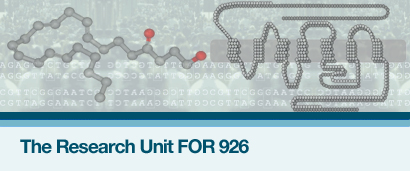The Research Unit 926 -
Physiology and Pathophysiology of the Endocannabinoid System
The term cannabinoids originally referred to bioactive compounds of the hemp plant Cannabis sativa. The major psychoactive cannabinoid THC (Δ9-tetrahydrocannabinol) activates two G-protein-coupled receptors, the cannabinoid receptors type 1 and 2 (CB1 and CB2). These receptors are also the primary target of lipid signaling molecules (endocannabinoids), in which 2-AG (2-arachidonoylglycerol) and anandamide (AEA) represent the major endogenous ligands (Pertwee 2005; Kogan and Mechoulam 2006). After discovery of the endocannabinoids, the scientific interest in the endocannabinoid system (ECS) was rapidly growing and to date different enzymes for biosynthesis, degradation and release of endocannabinoids were discovered.
The Research Unit 926 was initiated in 2008 with the idea that the ECS plays a critical role in the maintenance of the organism’s homeostasis. When exposed to a stressor, our body responds by the release of chemical mediators, which enable us to cope with the situation and to maintain a stable internal milieu. These reactions are initially beneficial for the organism, but the chronic elevation of the stress response mediators results in a cumulative “allostatic load”, which may contribute to pathological processes (McEwen 2007). There is a large body of evidence indicating that internal and external stressors trigger the activation of the ECS. As such, the ECS has systemic and local effects, by the modulation of neuronal and endocrine stress responses as well as by the modulation of cellular responses (Carrier et al. 2005). The short-term activation of the ECS is thus thought to constitute an important protective response against stress.
After the first three years we know consider that long-term changes in the activity of the ECS contribute to changes in organ functions. These changes are often detrimental and associated with disease pathology, but they can also be part of the normal aging process. We feel that the function of the ECS in maintaining homeostasis would be best addressed in an interdisciplinary consortium that attempts to clarify commonalities in the function or dysfunction of the ECS in different organ systems and developmental periods. We have therefore build up a consortium composed of research groups with a long-standing track record in cannabinoid research and groups who were interested in studying the ECS in the context of their primary research focus.
Our homepage provides information about the members of our consortium, the aims of the different subprojects and the progress in research during the second funding period.





